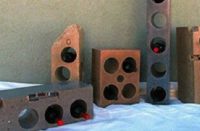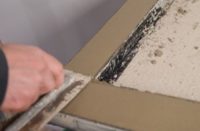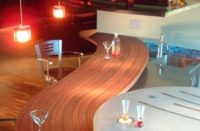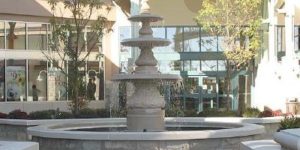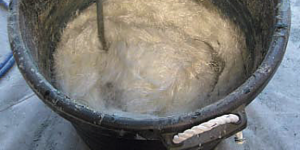I’ve heard it said that Las Vegas would not exist as we know it without glass-fiber reinforced concrete. If you took away all of the fountains, pyramids, fake ruins, boulders, castles, and building facades made with GFRC there wouldn’t be much left to look at.
GFRC is a combination of fine aggregate, cement, water, polymer, chemical admixtures and glass fiber. The key to GFRC is the glass-fiber reinforcement. The fibers take the place of steel in a wet-cast mix. They allow GFRC to develop much higher flexural strengths than typical wet-cast concrete, allowing you to cast thinner, lighter sections and pieces.
There is endless debate among concrete countertop professionals about which is better, wet-cast or GFRC. I don’t see either as better. If I were going for a look with a lot of exposed larger aggregate I’d wet-cast the piece, but if I were making an 8-foot ramp sink with a slot drain and a limestone-type look I’d use GFRC. I look at the project and decide what it needs to be. Sometimes it could be either, but sometimes one makes more sense than the other.

One of the main differences between the two is that you do not need a backup mold (on a sink or a drop-down edge) with GFRC, while you do need one with wet-cast. Another difference is the lack of larger aggregate in GFRC mixes.
GFRC concrete countertops and sinks typically consist of a sprayed-on face coat and a hand-placed fiber-reinforced back coat. This is known as “premix GFRC” – the fiber is mixed into the backing mix prior to placement. While the back coat in premix GFRC is typically hand-placed, it can also be sprayed with properly designed equipment. Larger GFRC producers use the “spray chop” method, which involves a specially designed gun that sprays cement slurry and chops AR (alkali-resistant) glass fiber, shooting both simultaneously into the mold.
You can also make self-consolidating GFRC pieces with no face coat. The fiber won’t show as long as you don’t polish the piece.
Ingredients and Their Functions
Cementitious binder:
The glue that holds things together.
– Portland type I is fine, white or gray – the choice is based purely on aesthetics. Find a source and stick with it. CSA (calcium sulphoaluminate) cement will also work.
– There are “all-in-a-bag” mixes, such as Fast Stone CW, produced and distributed by Ball Consulting Ltd. It contains white type I portland, Qwix cementitious additive and VCAS pozzolan. This mix features a 3-hour to 4-hour demold time.
Pozzolan:
– You do not need to use a pozzolan in your GFRC mix. However you can make denser, stronger and greener GFRC when you use one. I’ve been using a pozzolan made from post-consumer glass bottles with great success.
Fine aggregate:
– Most GFRC producers use gap-graded sand. “Gap-graded” means that the particles in a batch will fit through a screen with certain-sized gaps. A few smaller or larger particles might be mixed in. Sizes of sand used range from #30 to #60.
– I use concrete sand in my GFRC. I screen out the particles larger than #30 and am left with a mix of sizes up to #60. At $20 per ton it’s a bargain.
– As long as the particles don’t clog up the sprayer, just about any sound, inorganic sand will work to get the look you want.

Fibers
- AR (alkali-resistant) glass fibers are used in the back coat. You can use 1/2-inch or 3/4-inch fiber in your back coat. You will get slightly higher flexural strengths with the longer fiber.
- There are two different types of AR glass fibers. One is 100 filaments per strand and the other 200 filaments per strand. The 100-filament fiber is better for the direct-cast method (with no face coat) because it hides better in the matrix. The 200-filament fiber is better for the backup mix because it is stronger.
- There are also 1/8-inch and 1/4-inch dispersible fibers that work well in the direct-cast method in combination with the 100-filament products.
- I would consult your AR glass fiber supplier to determine the best choice for the intended use.
Basic chemicals
- Your dosage of superplasticizer, also known as high-range water reducer, will depend on what you are casting. A self-consolidating back coat will require more than a hand-placed vertical back coat.
- We will be using a polymer in our GFRC mixes.
Additional chemicals
- Nonchloride accelerating admixtures should not be needed as long as you cover the piece and keep it warm. Cement hydration slows to a crawl below 62 degrees. The solution is to cover the piece and add external heat if your shop is too cool. I use a PowerBlanket electric concrete-curing blanket to heat my GFRC to 120 F overnight.
- Qwix is a cementitious additive that increases the strength development of concrete mixes. It is also a very powerful accelerator. I prefer to use a combination of portland cement plus Qwix rather than using straight CSA cement when I need a faster turnaround. I have fewer bags laying around, it is more economical than shipping CSA cement to the job site, and straight CSA cement is difficult to work with in warmer weather.
- I would not recommend using a shrinkage-reducing admixture (SRA) with GFRC. The polymer already acts as a shrinkage reducer, making SRA use redundant with most polymers and possibly harmful when used with others.
Designing your GFRC mix
GFRC mixes are pretty basic. They are about a one-to-one ratio of sand to cement with water, polymer, fiber and chemicals. We’ll keep it simple and look at a typical batch rather than using the volumetric method.
This batch will have a density of about 125 pounds per cubic foot. The total weight of the batch is 236 pounds, not including fiber. The yield:
236 ÷ 125 = 1.9 cubic feet
- Cement: 100 pounds
- Sand: 100 pounds
- Polymer: 10 pounds Forton VF-774, an emulsion with 51 percent polymer solids.
- Water: Given a 0.31 water-to-cement ratio, you need 31 total pounds. There is water in the polymer emulsion, so how much should you add?
– You need to calculate the amount of water in your polymer. Forton VF-774 contains 51 percent solids and 49 percent water. You have 10 pounds of VF-774, and 49 percent of 10 pounds = 4.9 pounds.
Total weight of water to add to batch:
31.0 pounds (total water required) minus 4.9 pounds (water in the polymer) = 26.1 pounds (water we will weigh and add).
- Remember you will also have to compensate for moisture if you are using sand with moisture in it.
- Water: 26.1 pounds.
- Superplasticizer:3 ounces
- Optimum 380 should be added at 3 ounces per hundredweight of cement. We have about 1 hundredweight (100 pounds) of cement in our example mix so we’ll start with 3 ounces.
- Add more as needed to maintain your water-to-cement ratio while achieving your desired of fluidity.
- Fluidity per dosage of superplasticizer will vary with cement brand, cement type, aggregate size, aggregate shape, and fiber type and loading.
Finally … Fiber
- 7 pounds Fiber should be added at a rate of 3 percent of the 236.1-pound total batch weight (without it).
- 236.1 x 0.03 = 7 pounds
- That’s it. Simple math gets you quantities required for a specific project. For example: Say you need to cast a 4-foot by 8-foot slab that is 0.083 feet (1 inch) thick.
- 4 x 8 x 0.083 = 2.66 cubic feet required ÷ 1.9 (cubic feet per batch) = 1.4 batches required.
How you determine how much you mix at a time depends on your capacity.
Mixing GFRC
The goal when mixing GFRC is to end up with a thoroughly homogenized mix without beating up the fiber. The fiber is glass and will break down.
The optimum mixing method for GFRC is a high-shear mixer. A small high-shear mixer example would be a heavy-duty drill and paddle. Drill and paddle mixers work well for small face-coat batches with no fiber. Much larger-capacity specially made high-shear mixers are available to mix larger quantities of back coat at a time.
Another option is to mix your back coat in a barrel mixer or a vertical shaft mixer. I can mix 250 pounds of back coat at a time in my small barrel mixer and about 800 pounds of back coat at a time in my Imer vertical shaft mixer.
Mixing without getting cement lumps is a little tricky.
- Add all of the sand, some of the water and one fourth of the cement, and mix it.
- Gradually add the rest of the cement and water. Hopefully you will not get lumps of cement that don’t break up.
- Once this is fully mixed, add the fiber. Do not overmix the fiber, because you will break it up, rendering it useless. I would say that with my mixers, 1 minute of mixing time after the fiber is added gets it mixed in.
Green GFRC mix design
I’ve heard arguments stating that GFRC is green because it uses less material than wet-cast. That’s a tough argument to make due to the 50 percent portland cement content of GFRC verses the 25 percent cement content of wet-cast concrete. We all know that every pound of portland produced equals one pound of carbon dioxide released.
There are steps you can take to make greener (always a relative term) GFRC. Here’s a sample recipe.
- Cement: 80 pounds
- Bottle-glass pozzolan: 20 pounds
- Glass sand: 100 pounds
- Polymer: 10 pounds Forton VF-774
- Water: 26.1 pounds (0.31 water-to-cement ratio, or 31 total pounds in this case, minus the 4.9 pounds of water in the polymer. The pozzolan is counted as cement. For more explanation, see the discussion and numbers in the “Designing your GFRC mix” section.)
The neat thing about this mix is the bottle-glass poz and the glass sand all come from used bottles, giving this mix about 60 percent post-consumer waste product content.
More about polymer
A data sheet about polymer, from Ball Consulting Ltd.:
More about chemicals
www.concretecountertopsupply.com
www.ball-consulting-ltd.com
www.basf-admixtures.com
www.euclidchemical.com
www.fritzpak.com
www.grace.com
www.negamerica.com
More about fiber
www.nycon.com
www.ball-consulting-ltd.com
www.negamerica.com
